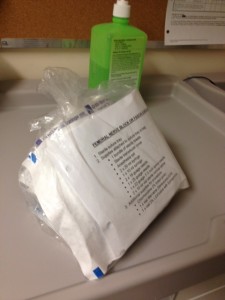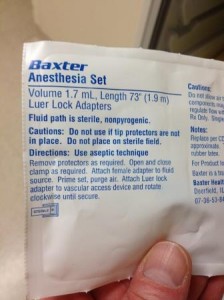Femoral nerve block gear
Even though we teach the femoral nerve block at EDE 2 and have collectively done a bunch ourselves, it still takes a bit of time to do the block. It’s not a 2-minute procedure. One of the battles is getting together all the gear needed to do the block. That gear is not usually all in one place in most EDs. You can shorten up the time it takes to do the block by having your ED admin put together a femoral nerve block kit. The order set for a femoral nerve block in the Sudbury ED includes the following. Item 2 is the kit.
1) Sterile suture tray
2) Femoral nerve block kit (see photo for what ours looks like) which contains the items listed below.
– 1 bundle of sterile towels
– sterile probe cover
– anesthesia set (just a long tube which connects syringe to needle; see the attached photos; not endorsing Baxter brand but it works fine)
– 2 x 20 mL syringes
– 1 x 10 mL syringe
– 2 x 18 gauge needles
– 1 x 25 gauge needle
– 1 x 22 gauge 3.5 inch spinal needle
– 2 x 10 mL vial sterile NS
Having ED personnel open all the items in the kit in a sterile manner on the suture tray is also a time-saver.
3) Additional supplies
– chlorhexidine 2% (“the pink stuff”)
– one vial bupivacaine (0.5%)
– one vial 2% lidocaine with epi
There’s more than one way to do it, but that’s our order set.
Click here for more on procedures at EM Cases: Jamie Blicker on Emergency Procedures










I think this is a great idea. The block itself takes only a couple of minutes at most to do once setup is complete. On a side note, I highly recommend taking a moment to use a pen to mark the skin of the leg that received a block. I like to document time and dose of local used as these patients are usually going to another floor and may have neurovascular vitals done at some point.
On my last shift the orthopaedic surgeon begged me to teach the rest of the department to do this block on his hip and femur fracture referrals as his patients really appreciate it.
One additional comment: Using 0.25% bupivicaine is quite reasonable as well and keeps you a little further away from cardiotoxic levels. It is the volume and proper distribution rather than the concentration that is most important for efficacy. Keep in mind that traditional blind or nerve stim blocks used 40-50ml of local in the past so don’t be afraid when you inject 15-20ml under US guidance.